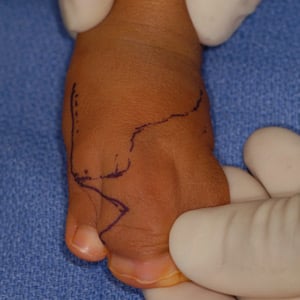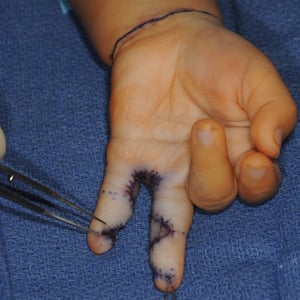Syndactyly (Webbed Fingers, Webbed Toes)
Syndactyly in the hand, where two or more fingers are not correctly separated is the most common congenital hand difference in children.
What is syndactyly?
Syndactyly is simply two or more fingers or toes that are connected at birth. The word comes from the Greek words syn (also sym), meaning "together," and daktylos, meaning "digit" (finger or toe). Sometimes also referred to as webbed fingers or toes, this condition occurs during fetal development.
What are the different types of syndactyly?
In syndactyly, there can be various degrees of webbing of the fingers or toes. Toe or finger webs can be made up of only the skin and soft tissues such as tendons and ligaments (simple syndactyly) or include lack of separation of the bones and nails as well (complex syndactyly). Only two digits may be together, sometimes three or four, and even all five digits can be together. The fingers and/or the toes can be affected.
Syndactyly of the fingers
In the hand, most syndactylies should be surgically treated. Thumb involvement is the most serious and usually requires earlier treatment before six months of age to allow the thumb and index fingers to grow unrestricted. The small and ring fingers are also of very different lengths, and therefore the small finger restricts the growth of the ring finger when they are stuck together. Usually the small/ring finger syndactylies are separated before a year of age. The ring, middle, and index fingers are of similar length and therefore syndactyly release can usually be delayed until two years of age.
If the fingers are partially separated, it is called an incomplete syndactyly. If the fingers are joined at the tips, it is called complete syndactyly. If the bones of the two fingers have not separated from each other, it is called a complex syndactyly. Syndactyly can also be part of a larger syndrome, such as Apert’s disease or ulnar longitudinal deficiency.
Below: Surgical planning and progressive treatment of incomplete syndactyly of the thumb with complete syndactyly of the remaining fingers.








Syndactyly of the toes
Although toe syndactylies are common, they rarely cause any functional deficit when left untreated. Often, they do not require surgery. One example that does require surgery is the rare case of syndactyly that includes the big toe and which also causes an early bunion. For this rare occasion, surgery is often performed by the upper extremity surgeon in conjunction with foot and ankle surgeons.
Synpolydactyly
Synpolydactyly, also misnamed "polysyndactyly," is a combination of polydactyly and syndactyly (extra fingers or toes and joined fingers or toes, respectively). The correct spelling from the Greek is actually sympolydactyly, from the words polydactyly meaning "many fingers" and sym meaning joined together. So, sympolydactyly means "joined many fingers" in Greek. (In English, both the prefix “syn” and “sym” are borrowed from this Greek root, as in the words “synthesis” and “symbiotic.”)
Synpolydactyly is nearly always inherited from a parent, although the phenotype, or how severely the child is affected, can vary from generation to generation. Synpolydactyly is most often a partial split of the finger that was to be the ring finger.
What causes syndactyly?
Syndactyly occurs during fetal development and is not caused by anything the mother did or did not do during pregnancy. It can be a consequence of many different syndromes, but more often it is an isolated condition.
At about four weeks of gestation (when the baby is the size of a poppy seed), a growing baby will develop limb buds that will become the arms and legs. At about six weeks, the hand begins to form in the shape of a paddle at the end of the limb bud. The paddle then develops four clefts, separating the hand paddle into four fingers and a thumb.
Occasionally, either because of a random occurrence or because it was genetically pre-programmed, one or more of those clefts does not form or does not form completely. The two fingers on either side of the cleft therefore never separate.
Another cause of syndactyly which happens through a different mechanism is amnionic band syndrome. The amnion is the outer membrane of a developing embryo, similar to the “skin” just under the shell of a hardboiled egg. In utero, the amnion can come loose and wrap itself around the developing arms, legs, hands, feet, and/or even the torso or the head. This loose amnion can squeeze the fingers together, causing them to grow into each other, creating a special syndactyly called acrosyndactyly. Acro from the Greek word ákros, means "high," and is used to describe the end of the arm or the tip of the fingers. In acrosyndactyly, the tips of the fingers are fused together, but the remnant of the original cleft remains, often as a small hole connecting the front to the back of the hand at the base of the finger.
A type of fused fingers can also occur from scarring after a child burns his or her hand. This is called a post-burn syndactyly and can be present in conjunction with other contractures of the hand or fingers.
How common is syndactyly?
Syndactyly is the most common congenital hand difference, occurring in one to two out of 1000 children. Amnionic bands, although more commonly known, are rarer, with an incidence of one in 10,000 children. Apert’s syndrome, a condition chiefly affecting the bones of the skull, but which can include syndactyly, is very rare, and occurs in one out of 75,000 children.
How is syndactyly diagnosed?
Syndactyly is a clinical diagnosis, meaning it is diagnosed by a physician evaluating the child in person. Although prenatal ultrasound can, in some cases, reveal the diagnosis, there are many cases that are not diagnosed until after the child is born, even if the mother has had routine prenatal ultrasounds.
Most children with syndactyly do not have any additional congenital differences or medical conditions associated with it, but some cases of syndactyly are part of a syndrome, or combination of several abnormalities that may be in different systems and organs of the body.
Can webbed fingers be separated?
Yes. Fingers stuck together at birth can be treated by hand surgeons with specialized training.
What type of doctor treats syndactyly?
Most patients with syndactyly are diagnosed initially by their pediatricians. Because most children with syndactyly require surgery for treatment, often your pediatrician will refer you to a specialist for surgical treatment. While both plastic surgeons and hand surgeons will treat syndactyly, it is best to find a surgeon with experience in treating children’s hands.
How is syndactyly treated?
Separation of webbed fingers or toes requires surgery. Although it may seem conceptually simple to incise the skin between the two digits, it’s actually quite complicated. Specific flaps of skin need to be used to minimize the chance of recurrent scar tissue called web creep. The most important part of the operation is the reconstruction of the base of the two fingers, called the commissure.
Operations to separate the fingers are usually done at or after two years of age to minimize the risk of anesthesia, but for thumbs and fingers that start to curve we recommend surgery at a younger age.
For children that have the condition on both sides we often recommend two surgical teams, one on each side, that work in parallel at the same time. This significantly decreases the anesthesia the child is exposed to and is a benefit of having several pediatric hand surgeons available at the same institution.
References
- Kozin SH, Zlotolow DA. Common Pediatric Congenital Conditions of the Hand. Plast Reconstr Surg. 2015 Aug;136(2):241e-257e. doi: 10.1097/PRS.0000000000001499. PMID: 26218399.
- Kozin SH, Zlotolow DA, Ratner JA. Venturing into the overlap between pediatric orthopaedics and hand surgery. Instr Course Lect. 2014;63:143-56. PMID: 24720302.
- Swarup I, Zhang Y, Do H, Daluiski A. Epidemiology of syndactyly in New York State. World J Orthop. 2019 Nov 18;10(11):387-393. doi: 10.5312/wjo.v10.i11.387. PMID: 31840019; PMCID: PMC6908446.



